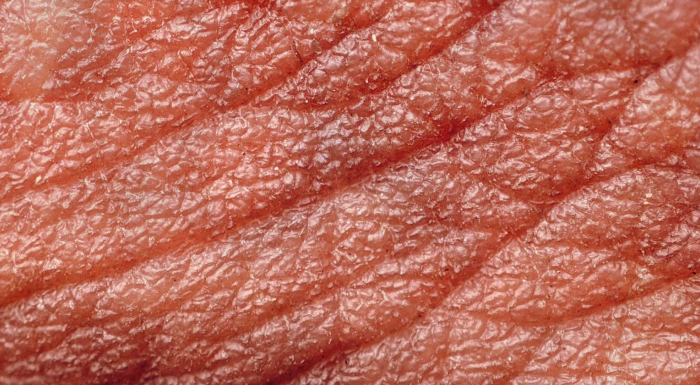Some day, robots will look so much like humans that distinguishing between them and us will be difficult. They will also have artificial skin that looks and functions like human skin and can sense the environment, respond to it and repair itself if cut or scratched.

Image Credit: Sciencenews
This sounds like science fiction, but in reality scientists have now created a substance with an artificial surface that has many of the same properties as biological tissues.
These properties are otherwise only present in living creatures, and this rare combination testifies to the pioneering and technically demanding nature of this discovery.
According to the researchers, the artificial surface could be used not only in robotics but also in healthcare and military applications.
“We are trying to develop something that can mimic the complexity and versatility that exists in biology. With this solution, we have developed a completely new material with capabilities no other material offers,” explains Alireza Dolatshahi-Pirouz, Group Leader and Associate Professor, Department of Health Technology, Technical University of Denmark, Kongens Lyngby.
The research has been published in Advanced Science.
Why the Human Body is Hard to Replicate
Alireza Dolatshahi-Pirouz’s research aims to develop something artificial with the same properties as what developed over billions of years of evolution. Skin and other biological tissues have properties that artificial materials usually cannot replicate – such as self-healing and sensory functions.
Biological materials such as skin, muscles and organ tissues can repair themselves when damaged – a feature artificial materials typically lack.
Our skin, muscles and bones can sense temperature, pressure and acidity – and artificial materials usually cannot.
Biological materials can also respond to changes in the environment. If we get too hot, we start to sweat. If bacteria or viruses invade the human body, the immune system reacts to it.
“Until now, making artificial materials that act like living tissue has seemed impossible. Artificial materials are often rigid and static and cannot repair themselves if they break or adapt to stimuli,” says Alireza Dolatshahi-Pirouz.
Feels Like Human Skin
Alireza Dolatshahi-Pirouz and colleagues developed a material with many of the same properties as living tissue.
The new substance is called graphene-poly (3,4-ethylenedioxythiophene):polystyrene sulfonate – combining graphene and an electrically conductive polymer. The material is soft and conductive and can heal itself in seconds because the electrically conductive connections between the molecules are automatically restored – similar to Velcro hook-and-loop tape coming back together.
Thanks to the unique molecular bonds in the graphene-based material, the artificial tissue can repair itself when damaged. The self-healing fabric repairs itself by rebuilding electrically conductive connections so it can still function after an injury – like skin that heals.
It can detect temperature, pH, pressure, humidity changes and biological signals such as dopamine, proteins, electrolytes, vitamins and hormones that indicate the state of the human body.
The soft sensor responds to its surroundings because it conducts electricity – just like nerves in the human body. For example, when the temperature rises, the material’s conductivity also increases.
The material senses biomolecules by exchanging electrons with the biomolecules.
“Electrochemistry enables us to determine whether the material has been in contact with biological molecules. This synthetic skin then responds to its surroundings, and we can measure that,” notes Alireza Dolatshahi-Pirouz.
Responds When Touched
The flexible surface can also respond to stimuli. As the surface warms up, it expands – just like human skin can sweat – and this can trigger the release of substances that can affect the environment.
In simple terms, imagine that a substance is released when the temperature rises. This enables the surface not only to sense that the temperature is rising but also to respond to this stimulus.
This advanced structure can also be controlled with electrical impulses – for example, researchers have made it flash an LED in response to touch or heat.
Imagine a robot working outside in winter – the material can help it keep warm. The robot can heat itself by sending electric current into the material and then continue working.
“The possibilities for this technology are vast and still unfolding,” says Alireza Dolatshahi-Pirouz.
Robots, Cancer Treatment – And Even Warfare
Imagination has also been at work in the laboratory, where Alireza Dolatshahi-Pirouz and colleagues are envisioning various applications for the discovery.
The most obvious application is in robotics, endowing machines with properties previously only seen in living tissue. Some robots may need only self-healing abilities, whereas others could benefit from a full suite of functions.
Another possible application is in healthcare technology: Alireza Dolatshahi-Pirouz also envisions the material being used in future cancer treatment. The material might be injected around a tumour and respond if it senses growth – for instance, by releasing more medication.
“I focus on healthcare applications, and you can also imagine using the material as a kind of sensor that measures the condition of the human body and responds automatically by releasing substances that help recovery: for example, by releasing more medicine if the body temperature rises,” explains Alireza Dolatshahi-Pirouz.
Finally, another potential application is in the military, where Alireza Dolatshahi-Pirouz imagines many miniature robots could detect weak points on an enemy military vehicle and disable key components, rendering the vehicle inoperative.
“Of course, this is all in the future, but for the first time we now have a material with all the same properties that are present in nature,” he concludes.